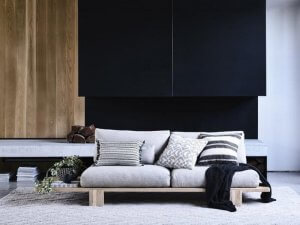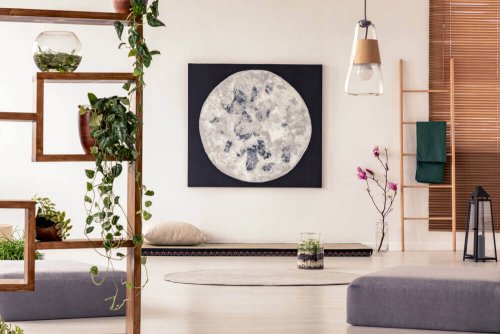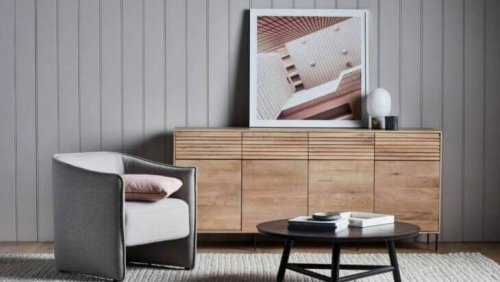Japandi Decorative Style - A Fusion of Cultures

One of the best ways to achieve harmonious spaces full of light is by applying the principles of the japandi decorative style, which is a fusion of cultures. This is a very original style that combines two decorative trends – Japanese and Scandinavian.
This interesting style blends the best of two ethnic-inspired trends that have been in vogue in recent years. More specifically, we’re talking about the hybrid between traditional Japanese minimalism and Scandinavian decor.
Also known as japanordic, it was chosen as the decorative trend of the year in 2017. However, despite having emerged a few years ago, it returned in full force in 2019. Below, we’ll show you the keys to this decorative style.
What’s the japandi decorative style?

As we stated above, the japandi decorative style combines two totally different themes, the Scandinavian and Japanese worlds, in one style. Despite the differences between the two concepts, they have many things in common, such as simplicity and focus on functionality.
However, the characteristic that best defines the personality of this trend is the balance between two very different styles.
- On one hand, it draws from the principles of the wasi-sabi philosophy of Japanese culture, where aesthetic harmony is based on the concept of the beauty of the imperfect.
- On the other hand, the japandi decorative style takes the warmth and comfort associated with the hygge concept from the Scandinavian world.
The japandi color palette

Vibrant and lush colors don’t necessarily characterize the japandi decorative style. Instead, this trend is reflected in warm and neutral colors.
- From the Scandinavian world, we can highlight soft colors, such as light gray, pale pink, baby blue, and pastel green.
- In contrast to the Scandinavian white, the muted and natural Japanese colors, such as brown or beige, help you achieve a warm and simple atmosphere.
To these color palettes, you can add details in black or dark gray. This creates a more dramatic atmosphere. However, you must refrain from using these colors to avoid disrupting the minimalist harmony of the design.
The importance of natural elements

The importance of nature is a principle that you can see in both Scandinavian and Japanese decor. Therefore, the goal is to strengthen the connection with Mother Earth by bringing it inside your home with different plants.
The use of the natural greens of plants helps you achieve a space full of vitality and strength. However, due to the influence of minimalism, you must be careful to avoid over-decorating your rooms with plants.
When it comes to choosing plants, instead of going for very colorful flower arrangements, it’s preferable to choose stylized and simple plants, such as bamboo or indoor palm trees.
Remember that quality over quantity is best when it comes to incorporating plants.
How to match your furniture with the japandi decorative style

As we mentioned above, the japandi decorative style is a hybrid of two different cultures. Thus, the furniture will be characterized by the combination of both decorative trends. Here are some of its main characteristics.
- The furniture stands out due to the use of straight lines and simple shapes. This enhances the importance of minimalism within this decorative style.
- On the other hand, low height furniture is very characteristic of this trend. This is a clear Japanese influence, where the feng shui philosophy establishes the importance of low furniture to connect people to the Earth.
- The color contrast is essential for a balanced space. One way to do this is by combining light and dark wood.
- The use of natural materials, such as wood or organic textiles, is also a defining characteristic of this style.
- Finally, you mustn’t forget the overall look of spaces. To connect with Scandinavian influence, you must make sure that the main pieces of furniture have their own atmosphere. This way, you avoid congesting rooms and, thus, achieve more open spaces.
https://midecoracion.com/casas/estilo-decorativo-japandi-fusion-de-culturas/
One of the best ways to achieve harmonious spaces full of light is by applying the principles of the japandi decorative style, which is a fusion of cultures. This is a very original style that combines two decorative trends – Japanese and Scandinavian.
This interesting style blends the best of two ethnic-inspired trends that have been in vogue in recent years. More specifically, we’re talking about the hybrid between traditional Japanese minimalism and Scandinavian decor.
Also known as japanordic, it was chosen as the decorative trend of the year in 2017. However, despite having emerged a few years ago, it returned in full force in 2019. Below, we’ll show you the keys to this decorative style.
What’s the japandi decorative style?

As we stated above, the japandi decorative style combines two totally different themes, the Scandinavian and Japanese worlds, in one style. Despite the differences between the two concepts, they have many things in common, such as simplicity and focus on functionality.
However, the characteristic that best defines the personality of this trend is the balance between two very different styles.
- On one hand, it draws from the principles of the wasi-sabi philosophy of Japanese culture, where aesthetic harmony is based on the concept of the beauty of the imperfect.
- On the other hand, the japandi decorative style takes the warmth and comfort associated with the hygge concept from the Scandinavian world.
The japandi color palette

Vibrant and lush colors don’t necessarily characterize the japandi decorative style. Instead, this trend is reflected in warm and neutral colors.
- From the Scandinavian world, we can highlight soft colors, such as light gray, pale pink, baby blue, and pastel green.
- In contrast to the Scandinavian white, the muted and natural Japanese colors, such as brown or beige, help you achieve a warm and simple atmosphere.
To these color palettes, you can add details in black or dark gray. This creates a more dramatic atmosphere. However, you must refrain from using these colors to avoid disrupting the minimalist harmony of the design.
The importance of natural elements

The importance of nature is a principle that you can see in both Scandinavian and Japanese decor. Therefore, the goal is to strengthen the connection with Mother Earth by bringing it inside your home with different plants.
The use of the natural greens of plants helps you achieve a space full of vitality and strength. However, due to the influence of minimalism, you must be careful to avoid over-decorating your rooms with plants.
When it comes to choosing plants, instead of going for very colorful flower arrangements, it’s preferable to choose stylized and simple plants, such as bamboo or indoor palm trees.
Remember that quality over quantity is best when it comes to incorporating plants.
How to match your furniture with the japandi decorative style

As we mentioned above, the japandi decorative style is a hybrid of two different cultures. Thus, the furniture will be characterized by the combination of both decorative trends. Here are some of its main characteristics.
- The furniture stands out due to the use of straight lines and simple shapes. This enhances the importance of minimalism within this decorative style.
- On the other hand, low height furniture is very characteristic of this trend. This is a clear Japanese influence, where the feng shui philosophy establishes the importance of low furniture to connect people to the Earth.
- The color contrast is essential for a balanced space. One way to do this is by combining light and dark wood.
- The use of natural materials, such as wood or organic textiles, is also a defining characteristic of this style.
- Finally, you mustn’t forget the overall look of spaces. To connect with Scandinavian influence, you must make sure that the main pieces of furniture have their own atmosphere. This way, you avoid congesting rooms and, thus, achieve more open spaces.
https://midecoracion.com/casas/estilo-decorativo-japandi-fusion-de-culturas/
All cited sources were thoroughly reviewed by our team to ensure their quality, reliability, currency, and validity. The bibliography of this article was considered reliable and of academic or scientific accuracy.
- Lazenby, Gina: El Feng Shui en la decoración, Blume, 2001.
- Sweet, Fay: Interiores escandinavos, Gustavo Gili, 2004.







